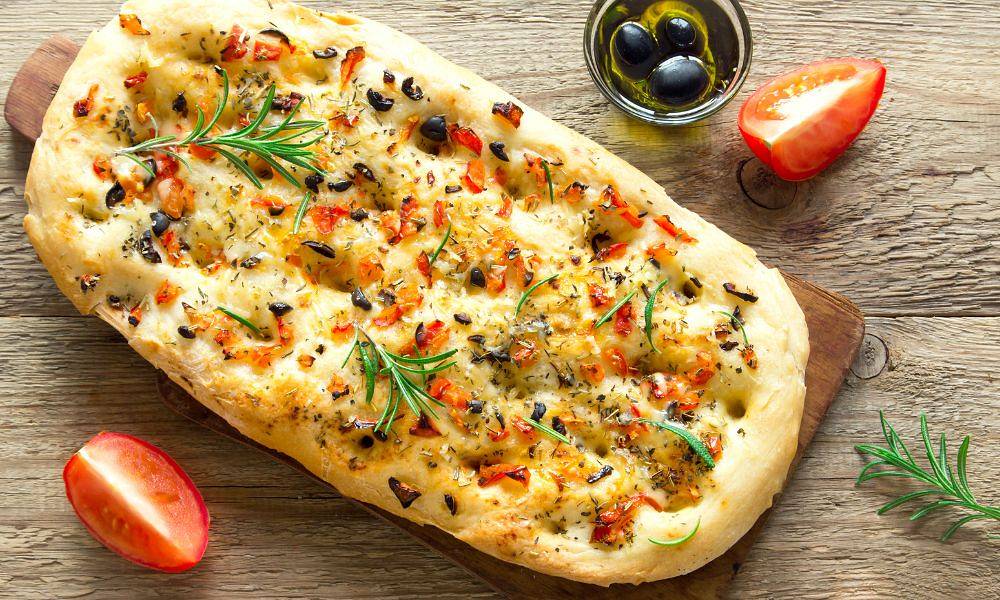If there is one bread that captures the soul of Italy — its history, its warmth, its effortless charm — it is undoubtedly focaccia. With its golden crust, airy interior, and intoxicating aroma of olive oil and herbs, focaccia is more than food.
It is a lifestyle. A taste of Liguria. A slice of Mediterranean joy that has traveled the world while remaining rooted in ancient tradition.
The bread of ancient times
The origins of focaccia stretch back thousands of years. In ancient Rome, panis focacius referred to a flatbread baked directly on hot embers. The word focus meant “hearth,” making focaccia quite literally the bread of the fire. Simple ingredients — flour, water, salt, and a generous brush of olive oil — transformed into a fragrant loaf that nourished families and brought communities together.
Some historians believe the idea predates Rome, tracing it to the Etruscans or ancient Greeks. What is certain is that the bread was never merely sustenance. It was part of social life: people gathering around the fire as the aroma of baking dough filled the air. That sense of conviviality still defines focaccia today.
Genoa and the heart of the tradition
When modern food lovers speak of focaccia, they often think of Genoa. In this Ligurian port city, focaccia genovese has become an art form. About one centimeter thick, generously dimpled by bakers’ fingertips, infused with briny water and olive oil — it is rustic perfection.
In Genoa, focaccia is woven into daily rituals. People eat it for breakfast, sometimes even dipping it into cappuccino, a combination that surprisingly works: sweet foam meets salty, olive-rich dough in perfect harmony. Long lines form each morning outside bakeries as locals reach for traditional or onion-topped slices, once considered “poor man’s breakfast,” now beloved by all.
Many regions, many faces
Like every Italian classic, focaccia boasts numerous regional variations.
In Puglia, potatoes are added to the dough for a softer crumb, often crowned with tomatoes, olives, and oregano.
In Recco, focaccia di Recco is a revelation — paper-thin layers of dough encasing molten cheese, so unique that it has earned protected IGP status.
In Veneto, focaccia becomes sweet around Easter, enriched with sugar, eggs, or raisins.
And in Tuscany, schiacciata offers a thinner, crispier bite, perfect with a drizzle of olive oil and flaky salt.
Each variation reflects a region’s character, proving that focaccia isn’t just bread — it is a cultural mirror.
Pizza or focaccia? The eternal question
Though often compared, the two differ significantly. Pizza is rolled thin and topped generously. Focaccia is thicker, richer in olive oil, and defined by its iconic dimples. It sits at the crossroads of bread and flatbread, simple yet characterful, humble yet full of personality.
A star of modern gastronomy
In recent years, focaccia has become a global culinary darling. Chefs experiment with toppings like grapes, zucchini blossoms, caramelized fruit, or vibrant “focaccia art,” where herbs and vegetables form edible landscapes. Meanwhile, purists still worship the simplicity of the Genoese style — crisp edges, airy crumb, and pure olive oil flavor.
Bakers recommend techniques such as sprinkling dough with salted water before baking to create the signature crust. Whether traditional or modern, focaccia has proven its limitless versatility.
How to bring Italy into your kitchen
A classic Ligurian-inspired recipe remains the ideal gateway: flour, olive oil, water, salt, a bit of yeast, and patience. After rising, the dough is gently pressed into a pan, dimpled with fingertips, and lavishly brushed with garlic- and rosemary-infused oil. A sprinkle of coarse sea salt, a hot oven, and minutes later the kitchen fills with the scent of the Mediterranean.
A bite of Italy
When the focaccia emerges golden and fragrant, crisp on the outside and soft inside, it offers more than flavor. It offers a moment — a connection to centuries of tradition, to communal hearths, to sunlit Ligurian mornings. In every bite, Italy whispers its story.

